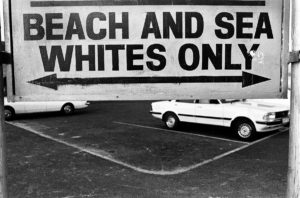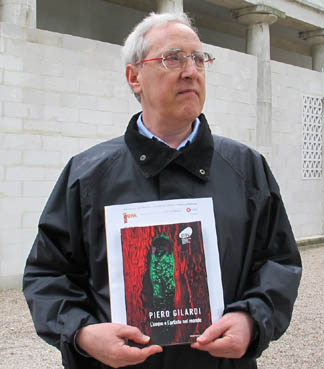Angela Madesani is an art historian, a critic and an independent curator. Among the exhibitions signed by her we can mention: “Utopie quotidiane” (Daily Utopias) at the PAC in Milan (together with Vittorio Fagone, 2002) and “Cantieri dell’Arte” at the former Cartiere Binda in Milan (2004), she curated the first edition of “Fotografia Europea” (European Photography) in Reggio Emilia (2006) and Kaléidoskope d’Italie at the CNA of Dudelange, in Luxembourg (2009). Among her numerous publications, we note: “Rubare l’immagine. Gli artisti e la fotografia negli anni Settanta” (Stealing the image. Artists and photography in the Seventies) (2001), “Il mondo dei Carpi” (The Carpis’ world) (Mazzotta, 2001); “Le icone fluttuanti. Storia del cinema d’artista e della videoarte in Italia” (The floating icons. History of art films and video art in Italy) (Bruno Mondadori publisher, 2002); “Storia della fotografia” (History of photography) (Bruno Mondadori publisher, 2005); “Le intelligenze dell’arte. Gallerie e galleristi a Milano 1876-1950” (The intelligence of art. Galleries and gallery owners in Milan 1876-1950) (Nomos, 2016). She is also the author of numerous monographs of prestigious authors including Gabriele Basilico, Giuseppe Cavalli, Franco Vaccari, Vincenzo Castella, Francesco Jodice, Anne and Patrick Poirier, Luigi Ghirri, Giulio Paolini.
We talk with Angela Madesani about her education and her upcoming work commitments.
Can you tell us about your education and how and why did you start dealing with contemporary visual culture?
I attended the faculty of Arts at the State University in Milano. I asked the professor of Medieval Art History for a thesis, since in that period, in Milan, there was no chair for History of Contemporary Art. Later on, Maria Mimita Lamberti took up the teaching, but I could not ask her to be my thesis advisor, even though I had already understood that that was the area I was interested in. In 1991 I graduated and immediately started collaborating with newspapers and magazines, even if I was not interested in dedicating myself to journalism, since my passion was studying. I also realized that attending artists’ studios was an extraordinary privilege, so I started to devote myself to militant criticism. Since 1996 I have curated exhibitions without interruption. I could not do any other job. Since I was a child, books have been a great passion of mine and over the years I have collected almost 25 thousand volumes, with particular attention, in the last ten years, to artist’s books.
At some point you decided for a turn and you have dedicated yourself specifically to the world of photography. Is there any motivation behind your choice?
In reality photography has always been present in my thoughts. First I liked to handle cameras then I started, just after graduation, to take an interest in the history of photography. It is no coincidence that the first catalogue for which I wrote a text was dedicated precisely to the work of a photographer, Maria Mulas.
At the moment, with a world recession “in progress”, from an Italian perspective, how do you see the future of contemporary photography?
Disastrous conjunctures permitting, I do not think the art market will collapse and photography is now part of it. As it always happens during world crises, there will be a cleansing. A lot of junk will disappear, other will come. Important works will keep up. It is desirable that collectors will be able to understand that purchases should not be made only with the help of Artprice and the various occasional cultural fashions, but by studying and inquiring. I know some of them who act like this, driven by curiosity and study, and have put together extraordinary collections that have also a great economic value.
If you had extra money available, what photographers’ works do you think would be fair to buy?
I would buy post-war Italian photography, the great refined masters who still have low prices. The Bussola photographers for example. Then I would buy works made by artists who used photography in the period from the sixties to the seventies. There are wonderful things that deserve to be looked at with different eyes.
What if you had to make suggestions to a young collector with limited financial means?
I would give the advice I gave earlier: read and look a lot in order to form a personal taste.
The XVIII Biennale Donna (Palazzina Marfisa d’Este, Ferrara) will open shortly from 20 September to 22 November 2020, and then later on (from 3 October 2020 to 10 January 2021, Fondazione Ragghianti, Lucca) the exhibition dedicated to the Cioni Carpi’s experiments. Both these exhibitions are signed by you; can you tell us something about each of them and why they deserve a visit?
The Biennale Donna in Ferrara is dedicated this year to reportage photography, there are interesting discoveries to make, some excellent foreigners who are hardly known here and the discovery of great photographers such as Lori Sammartino or Chiara Samugheo, placed next to Diane Arbus, Letizia Battaglia and Lisetta Carmi. Cioni Carpi was a great artist, a refined intellectual who deserves a rediscovery. His works, besides being beautiful, are visionary, full of intelligent ideas. I am grateful to Paolo Bolpagni for being corageous in having me as curator of this exhibition.
Your plans or forecasts for 2021?
I just keep my fingers cross as I don’t like to talk about future. I have some research in the drawer. I want to study and find out. I hope that people attending the exhibitions will be able, while chatting away, to grasp the meaning of what they are looking at, allowing themselves with a few moments of observation and reflection.
(Translated by Luisa Pettener)
 Paola Agosti, Sud Africa, Cape Town, 1983. © Paola Agosti, ph courtesy XVIII Biennale Donna, Ferrara
Paola Agosti, Sud Africa, Cape Town, 1983. © Paola Agosti, ph courtesy XVIII Biennale Donna, Ferrara
 Giovanna Borgese, Torino, 1980, ph courtesy XVIII Biennale Donna, Ferrara
Giovanna Borgese, Torino, 1980, ph courtesy XVIII Biennale Donna, Ferrara
 Lisetta Carmi, Genova-Porto, sala chiamata, 1964, © Lisetta Carmi, ph courtesy Martini & Ronchetti (opera esposta alla XVIII Biennale Donna di Ferrara)
Lisetta Carmi, Genova-Porto, sala chiamata, 1964, © Lisetta Carmi, ph courtesy Martini & Ronchetti (opera esposta alla XVIII Biennale Donna di Ferrara)
 Cioni Carpi, tavole per Un gatto qua e là, 1962, tecnica mista su carta, cm 13 x 17, © Alberto Messina 2020, ph courtesy Fondazione Ragghianti, Lucca
Cioni Carpi, tavole per Un gatto qua e là, 1962, tecnica mista su carta, cm 13 x 17, © Alberto Messina 2020, ph courtesy Fondazione Ragghianti, Lucca

He is editorial director of Juliet art magazine.






NO COMMENT